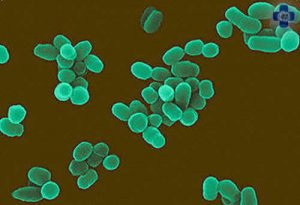
All iLive content is medically reviewed or fact checked to ensure as much factual accuracy as possible.
We have strict sourcing guidelines and only link to reputable media sites, academic research institutions and, whenever possible, medically peer reviewed studies. Note that the numbers in parentheses ([1], [2], etc.) are clickable links to these studies.
If you feel that any of our content is inaccurate, out-of-date, or otherwise questionable, please select it and press Ctrl + Enter.
Bacillus cereus - causative agents of food toxic infections
Medical expert of the article
Last reviewed: 04.07.2025
 ">
">Bacillus cereus plays an important role in the etiology of food poisoning. B. cereus are gram-positive, non-encapsulated bacteria measuring 1.0-1.2 x 3-5 μm, motile (peritrichous) or non-motile. The cells tend to be arranged in chains, the stability of which largely determines the shape of the colony, which varies greatly among strains. They form ellipsoid spores that are located centrally but do not expand the cells. Bacteria grown on glucose agar contain lipid inclusions in the form of droplets (poly-b-hydroxybutyric acid) at an early stage of growth, and often volutin grains.
B. cereus are chemoorganotrophs, aerobes or facultative anaerobes, and are capable of growing in a column of anaerobic agar. The G+C content of DNA is 32-37 mol%.
They are usually catalase-positive. They reduce nitrates to nitrites; ferment glucose, maltose, and often sucrose to form only acid, without gas; do not ferment mannitol; form acetoin (positive Voges-Proskauer test), lecithinase, and grow on citrate medium as well as in the presence of 0.001% lysozyme. The optimum temperature for their growth is 35-45 °C, the temperature range for growth is 10-45 °C. They synthesize and secrete hemolysin, exotoxins, enzymes that lyse bacterial cells, proteolytic enzymes, phospholipase C, some strains form a red pigment on a medium with starch and iron, and some form fluorescent yellowish-green pigments on various media. Different strains require one or more amino acids for growth. On a dense medium, they form colonies that have different appearances depending on the stability of the arrangement of cells in chains. In some cases, dull or frosted glass colonies with wavy edges and no processes are formed. In other cases, the colonies have root-like processes that spread widely over the surface of the agar. The processes can either have the appearance of random interweaving or be bent in different strains in a clockwise or counterclockwise direction.
On yolk-salt agar with polymyxin, B. cereus forms waxy colonies with jagged edges, surrounded by a rainbow halo (positive test for lecithinase). Habitats - soil, water, plant substrates.
B. cereus is very similar in its properties to B. thuringietisis and differs from it in the absence of toxic protein crystals in the cells.
According to O-antigens, 13 serotypes have been identified in the B. Cereus B. thuringietisis group. They also differ in their H-antigens.
Some strains of B. cereus are pathogenic for humans and animals. In particular, the role of B. cereus in the etiology of food toxic infections has been established. The pathogenicity of B. cereus is associated with its ability to synthesize and secrete two exotoxins. One of them consists of three protein components, has diarrheagenic, lethal activity and increases vascular permeability (diarrheagenic-lethal toxin). The second toxin, cereolysin, causes a cytolytic and lethal effect and also disrupts the permeability of blood vessels.
When pathogenic variants of B. cereus enter food products, they multiply in them and produce exotoxins. Under the influence of proteolytic and other enzymes secreted by B. cereus, various toxic substances (ptamines) accumulate in the products. All this taken together leads to the development of food poisoning. Infection most often occurs when consuming plant products and milk contaminated with B. cereus (40-55%), as well as animal products (25%) and other products.
In bacteriological diagnostics of such food poisonings, it is necessary to pay attention to the quantitative content of B. cereus in products (10s-10b or more cells in 1 g), their isolation from feces and wash water in large quantities, simultaneous isolation from several people in case of group poisoning, etc. Serological confirmation of the diagnosis is provided by the detection of antibodies to B. cereus in the serum and an increase in their titer.


 [
[